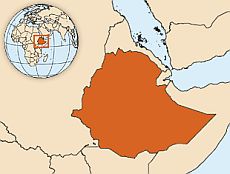Based on Ethiopia's ranking in three domains basic to the response to COVID-19 outbreak (epidemiologic situation, health care preparedness, public health capacity), this article recommends strict mitigation measures to be practiced
credit: WHO
By Garumma Tolu Feyissa (PhD),1€ Lemi Belay Tolu (MD),2 Alex Ezeh (PhD)1
1Dornsife School of Public Health, Drexel University, Philadelphia, Pennsylvania, USA
2 Family Planning Fellow, Department of Obstetrics and Gynecology, Saint Paul Hospital Millennium Medical College, Addis Ababa, Ethiopia
How Prepared is Africa for the COVID-19 Pandemic Response? The Case of Ethiopia
The coronavirus disease 2019 (COVID-19) is an ongoing pandemic caused by severe acute respiratory syndrome coronavirus 2 (SARS-CoV-2). The outbreak was first identified in Wuhan, Hubei Province, China, in December 2019. The World Health Organization (WHO) recognized it as a pandemic on 11 March 2020. As of May 25, 2020, more than 5,525,299 cases of COVID-19 have been reported in over 200 countries, causing 347,114 deaths. As of May 25, 2020, Ethiopia has registered total of 655 confirmed COVID-19 cases.
How prepared is Ethiopia for pandemic response?
Preventepidemics.org has created ReadyScore to determine whether a country is prepared to find, stop, and prevent epidemics. The score is based on 19 criteria to determine the level of countries preparedness and capability to control outbreaks. Countries are classified into five: Better prepared (over 80%), work to do (40-80%), not ready (under 40%), in progress and unknown. Ethiopia ReadyScore is 52 %.
Ethiopia’s COVID-19 Response
Since the COVID-19 was reported, Ethiopia started screening passengers at Bole international airport. Public Health Institute (EPHI) started laboratory test for COVID-19 and dedicated Eka Kotebe Hospital for COVID-19. Hand washing, cough hygiene and physical distancing were highly advocated. Ethiopia closed all night bars, schools including universities and abandoned religious gatherings. Additionally, mandatory quarantining of passengers, testing suspected cases and contact tracing were done.
What measures should be taken to mitigate the pandemic
In addition to the measures taken so far, it would critical to follow the guideline prepared by Resolve to Save Lives to decide when to loosen or tighten physical distancing measures.
When and How to Close due to COVID-19 Spread
Decision to tighten physical distancing depends on three domains of decision: level of viral transmission, health care preparedness and public health capacity. Accordingly, strict mitigation measures are needed when one or more criteria in at least 2 of 3 domains are met (When to Tighten).
The current situation of Ethiopia in accordance to the three decision domains:
1. Ethiopia’s COVID-19 Epidemiologic situation
Ethiopia showed 11% growth in past 24-48 hours on April 16,2020. Physical distancing was less implemented in major cities including Addis Ababa. This will increase the likelihood of exposure through mass gathering or congregation of people. Mass screening asymptomatic cases is not being carried out because of the limited capacity and the likelihood of delayed detection of cases is high. According to EPHI report currently, about 20 contacts have been identified for each confirmed case, with this about one third of the population would be infected at the peak. From the domain of prevention strategy, reducing contacts by 50% through enforcing physical distancing averts 15 million infections that would have occurred at the peak at the national level.
2. Ethiopia’s COVID-19 health care preparedness
Though different repurposing activities are undergoing, Ethiopia has limited health care capacity especially of Intensive Care Unit (ICU). Ministry of Health (MOH) recently disclosed to media that Ethiopia has totally 450 mechanical ventilators in both private and government settings. The number of Covid-19 cases is increasing daily, there are more admissions and less discharges. Additionally, Ethiopia has limited personal protective equipment.
3. Ethiopia’s COVID-19 public health capacity
Ethiopia is having congested mandatory quarantine because of continued flying airlines, especially more cases coming from Dubai. Given the longstanding social bond in the community, it is not easy to fully implement physical distancing recommendations. In addition, it will not be an easy task for the majority who live on daily labor in this era of quarantine since the government does not have capacity to provide life sustaining supplies or cash to each. Though there is commitment from the side of the government, clear operational guideline is missing and there is also weakness in the enforcement of the mitigation measures on the ground.
What should be the next immediate pandemic adaptive response for Ethiopia?
Depending on Ethiopia’s situation on the three decision domains, we recommend strict mitigation measures to be practiced. Hence, we recommend that Ethiopian government to tighten the following actions urgently:
- Mass communication and community mobilization.
- Strict social distancing measures.
- Sanitary measures.
- Maximizing case tracing and detection.
- Developing detailed operational guidelines on preventive measures across different business, organizational and community settings.
- Measures for sustaining essential health services.
- Proactive measures to sustain life during the lockdown.
When and How to Reopen After COVID-19
COVID-19 physical distancing measures can be loosened when all the criteria under three domains of decision: level of viral transmission, health care preparedness and public health capacity are met. Hence we recommend Ethiopia to strategically decide when and how to reopen according to When and How to Loosen.
———————————————
€Correspondence to Garumma Tolu Feyissa E-mail: garummatolu@yahoo.com
